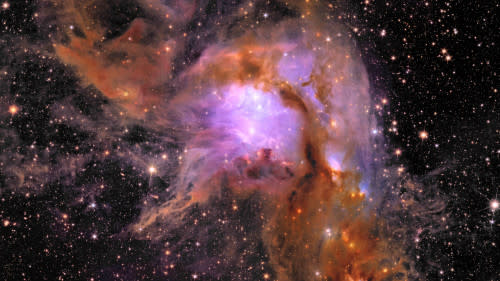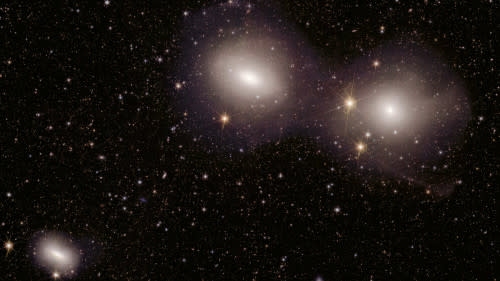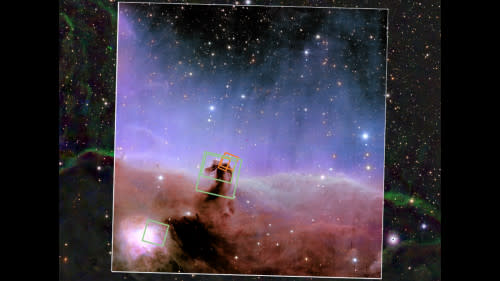After viewing just a single day’s worth of observations from the new Euclid space mission, astronomers are already on the edge of their seats, excited for what they may reveal about the cosmos. However, these images are also inspiring awe and wonder about the beauty of the universe around us.

Euclid captures NGC 6744, one of the largest spiral galaxies beyond our local patch of space. It’s a typical example of the type of galaxy currently forming most of the stars in the nearby Universe, making it a wonderful archetype to study with Euclid. (ESA/Euclid/Euclid Consortium/NASA, image processing by J.-C. Cuillandre (CEA Paris-Saclay), G. Anselmi)
“The images taken by Euclid are so sharp and so big that they allow us to spot objects that would be invisible from Earth, including so-called ‘jellyfish’ galaxies and other dim or fuzzy cosmic objects,” Dr. Douglas Scott, a professor of astronomy and astrophysics at the University of British Columbia who is one of four Canadian spokespeople for the Euclid consortium, said in a UBC press release.
“Euclid was designed to look at the dark universe so it takes amazingly detailed pictures of the sky from space,” Scott explained.
“But this means that the data are useful for studying the bright universe too, beyond the mission’s objectives,” he added. “With just a day’s worth of data, we’re already finding planet-sized objects nearby and probing the nature of dark matter through gravitational lensing.”


Euclid’s image of Messier 78, a vibrant region of star formation shrouded by interstellar dust. (ESA/Euclid/Euclid Consortium/NASA, image processing by J.-C. Cuillandre (CEA Paris-Saclay), G. Anselmi)
DON’T MISS: Comet fragment lights up sky over Spain and Portugal ‘like a movie’
The above image reveals Euclid’s unprecedented view of Messier 78 (or M78), an immense cloud of gas and dust in the Orion constellation that is a region of intense star formation. According to the European Space Agency, Euclid’s cameras have explored this young star-forming region at a width and depth never before captured.
“Euclid peered deep into this nursery using its infrared camera, exposing hidden regions of star formation for the first time, mapping its complex filaments of gas and dust in unprecedented detail, and uncovering newly formed stars and planets,” the ESA said. “Euclid’s instruments can detect objects just a few times the mass of Jupiter, and its infrared ‘eyes’ reveal over 300,000 new objects in this field of view alone. Scientists are using this dataset to study the amount and ratio of stars and smaller (sub-stellar) objects found here — key to understanding the dynamics of how star populations form and change over time.”
While the above image is beautiful, it is even more spectacular when you zoom in to explore the details using ESASky.


Here, three prominent members of the Dorado Group of galaxies are shown in one of Euclid’s first science images, with the two larger ones in the process of merging. (ESA/Euclid/Euclid Consortium/NASA, image processing by J.-C. Cuillandre (CEA Paris-Saclay), G. Anselmi)
“It is incredibly exciting that we are now seeing scientific results from the early data taken by Euclid,” Dr. Will Percival, a primary science coordinator for the Euclid space mission at the University of Waterloo, said in a press release.
“Just 24 hours of pointing at known astronomical objects has already provided interesting scientific results,” Percival said. “Survey operations currently underway will not just look at known objects but will cover a huge patch of the observable universe. The potential for future discoveries of previously unknown objects is huge and exciting.”
READ MORE: Europe’s Euclid mission launches to unveil the ‘dark universe’
Euclid vs Hubble vs JWST
While Euclid can easily be compared with the Hubble and James Webb space telescopes, it represents a fundamental shift in viewing the cosmos.
Hubble and JWST focus on very small portions of space, gathering as much light as possible from those tiny regions to reveal greater details of an object, or to peer farther out into the universe and thus further back in time.
Each image from Euclid, though, captures a far larger field of view.


This large colourful view of the Horsehead Nebula (bordered in white) was captured by the Euclid telescope, while the green squares represent the size of Hubble’s view and orange rectangles reveal JWST’s view. (ESASky)
“In a single observation Euclid can record the data from an area of the sky more than one hundred times bigger than that imaged by Webb’s camera, NIRCam,” says the ESA.
This capability will allow Euclid to map roughly one third of the entire sky over the next six years, something that would be impossible for either Hubble or JWST.
Watch below: Euclid ‘dark universe’ telescope captures images of distant galaxies
Source Agencies


